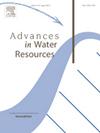The role of injection method on residual trapping: Insights into bridging scales and heterogeneity
IF 4
2区 环境科学与生态学
Q1 WATER RESOURCES
引用次数: 0
Abstract
CO injection into subsurface reservoirs provides a long-term solution to anthropogenic emissions. A variable injection rate (such as ramping the flow rate up or down) provides flexibility to injection sites, and could influence the amount of residual trapping. Observations made in cm-scale samples showed that starting at a low flow rate established a flow pathway across the core at a low capillary pressure, leading to a long-term reduction in pore space utilization, as increases in flux were accommodated with little change in saturation. In this work, the scalability of these observations is evaluated by performing experiments with variable injection rates in larger samples: 5 cm diameter and 12 cm length, compared to 2.5 cm diameter and 4.5 cm length in previous work (Spurin et al., 2024). We observed that starting at a low flow rate did not lead to a long-term reduction in pore space utilization. Instead, saturation increased significantly with increased flux, leading to a higher pore space utilization than experiments where injection started with the higher flow rate. The difference in observations depending on sample size and the role of heterogeneity highlights potential uncertainties in upscaling experimental observations to field-scale applications.
注入方法在残余圈闭中的作用:对桥接尺度和非均质性的见解
向地下储层注入二氧化碳是解决人为排放问题的长期办法。可变的注入速率(例如提高或降低流量)为注入部位提供了灵活性,并可能影响剩余捕获量。cm尺度样品的观察表明,从低流速开始,在低毛细压力下建立了一条穿过岩心的流动通道,导致孔隙空间利用率长期降低,因为通量的增加与饱和度的变化很小。在这项工作中,通过在更大的样本中进行不同注射速率的实验来评估这些观察结果的可扩展性:直径5厘米和长度12厘米,而之前的工作中为直径2.5厘米和长度4.5厘米(Spurin et al., 2024)。我们观察到,从低流速开始并不会导致孔隙空间利用率的长期降低。相反,随着流量的增加,饱和度显著增加,导致孔隙空间利用率高于以高流速开始注入的实验。观测结果的差异取决于样本量和异质性的作用,这突出了将实验观测扩大到野外规模应用的潜在不确定性。
本文章由计算机程序翻译,如有差异,请以英文原文为准。
求助全文
约1分钟内获得全文
求助全文
来源期刊

Advances in Water Resources
环境科学-水资源
CiteScore
9.40
自引率
6.40%
发文量
171
审稿时长
36 days
期刊介绍:
Advances in Water Resources provides a forum for the presentation of fundamental scientific advances in the understanding of water resources systems. The scope of Advances in Water Resources includes any combination of theoretical, computational, and experimental approaches used to advance fundamental understanding of surface or subsurface water resources systems or the interaction of these systems with the atmosphere, geosphere, biosphere, and human societies. Manuscripts involving case studies that do not attempt to reach broader conclusions, research on engineering design, applied hydraulics, or water quality and treatment, as well as applications of existing knowledge that do not advance fundamental understanding of hydrological processes, are not appropriate for Advances in Water Resources.
Examples of appropriate topical areas that will be considered include the following:
• Surface and subsurface hydrology
• Hydrometeorology
• Environmental fluid dynamics
• Ecohydrology and ecohydrodynamics
• Multiphase transport phenomena in porous media
• Fluid flow and species transport and reaction processes
 求助内容:
求助内容: 应助结果提醒方式:
应助结果提醒方式:


